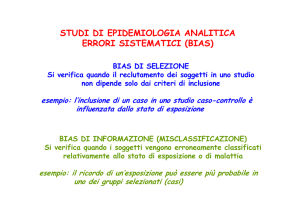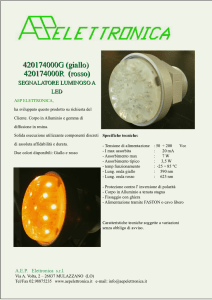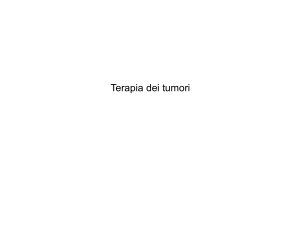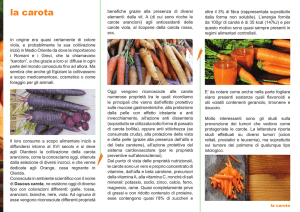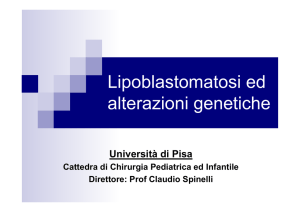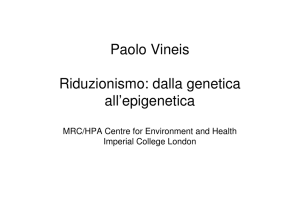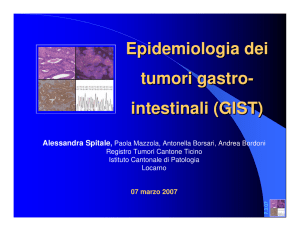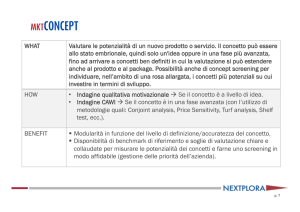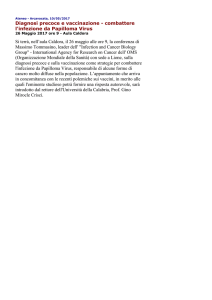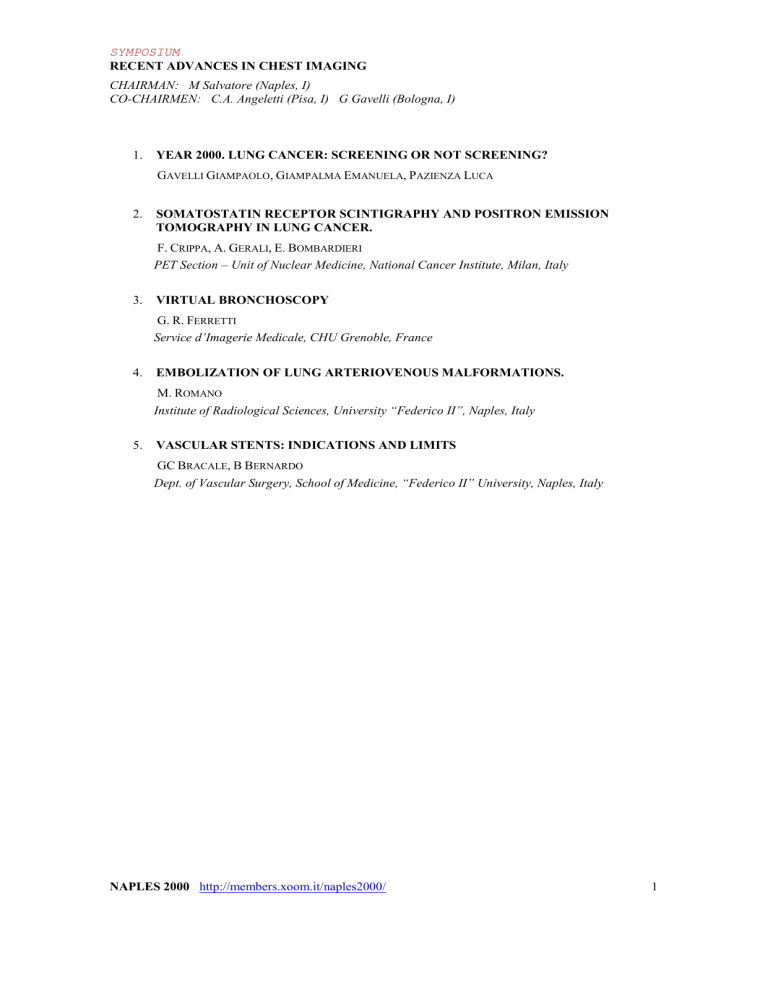
SYMPOSIUM
RECENT ADVANCES IN CHEST IMAGING
CHAIRMAN: M Salvatore (Naples, I)
CO-CHAIRMEN: C.A. Angeletti (Pisa, I) G Gavelli (Bologna, I)
1.
YEAR 2000. LUNG CANCER: SCREENING OR NOT SCREENING?
GAVELLI GIAMPAOLO, GIAMPALMA EMANUELA, PAZIENZA LUCA
2.
SOMATOSTATIN RECEPTOR SCINTIGRAPHY AND POSITRON EMISSION
TOMOGRAPHY IN LUNG CANCER.
F. CRIPPA, A. GERALI, E. BOMBARDIERI
PET Section – Unit of Nuclear Medicine, National Cancer Institute, Milan, Italy
3.
VIRTUAL BRONCHOSCOPY
G. R. FERRETTI
Service d’Imagerie Medicale, CHU Grenoble, France
4.
EMBOLIZATION OF LUNG ARTERIOVENOUS MALFORMATIONS.
M. ROMANO
Institute of Radiological Sciences, University “Federico II”, Naples, Italy
5.
VASCULAR STENTS: INDICATIONS AND LIMITS
GC BRACALE, B BERNARDO
Dept. of Vascular Surgery, School of Medicine, “Federico II” University, Naples, Italy
NAPLES 2000 http://members.xoom.it/naples2000/
1
SYMPOSIUM
RECENT ADVANCES IN CHEST IMAGING
CHAIRMAN: M Salvatore (Naples, I)
CO-CHAIRMEN: C.A. Angeletti (Pisa, I) G Gavelli (Bologna, I)
YEAR 2000. LUNG CANCER: SCREENING OR NOT SCREENING?
Gavelli Giampaolo, Giampalma Emanuela, Pazienza Luca
Negli anni settanta diversi studi furono effettuati per valutare il ruolo dello screening mediante
radiografia del torace nei pazienti a rischio di sviluppare una neoplasia polmonare maligna (4, 5, 6, 12,
13, 15, 18).
Questi trials non dimostrarono però riduzione della mortalità per tumore polmonare nella popolazione
studiata, per cui venne esclusa una reale utilità dello screening nella diagnosi precoce del tumore
polmonare.
Recentemente Strauss(2), dopo una attenta metanalisi dei suddetti lavori ha messo in discussione
questa affermazione, riabilitando, almeno in parte, il ruolo del radiogramma del torace che, se comparato
allo screening con citologia dell'espettorato mostra una maggiore sensibilità (77% rispetto a 42%).
In particolare, anche se lo screening mediante radiografia standard non modifica significativamente la
percentuale di mortalità(National Cancer Data Base 1992), è dimostrato una sua efficacia nell'aumentare
la percentuale di neoplasie identificate in stadio I e II, con conseguente aumento della resecabilià e della
sopravvivenza dei pazienti(4, 16).
E' stato dimostrato che l'incidenza della neoplasie diagnosticate allo stadio I raggiunge il 42-50% in
corso di screening contro il 16-18% riscontrato nella popolazione generale.
Da ciò deriva un miglioramento della sopravvivenza a 5 anni dei pazienti con neoplasia polmonare
che passa dal 15,6% della popolazione generale al 29,6% della popolazione sottoposta a screening.
Nonostante i risultati ottenuti, il radiogramma del torace mostra peraltro scarsa sensibilità e specificità
nella dignosi precoce del tumore polmonare sia per limiti fisici intrinseci alla metodica sia per i fattori
dipendenti dalle caratteristiche proprie della lesione.
Numerosi Autori(14, 20) hanno rilevato come circa il 90% dei tumori periferici e il 65% dei tumori
ilari, diagnosticati in corso di screening con il radiogramma del torace avrebbero potuto essere evidenziati
anche in radiografie eseguite alcuni mesi o anni prima.
Da quanto detto appare chiaro come l'alta percentuale di falsi negativi ottenuta mediante radiogrammi
standard del torace rendono tale metodica non affidabile, in particolare nell'esecuzione di uno screening.
La metodica di imaging che si è andata affermando come gold standard per la diagnosi dei noduli
polmonari è la TC, specie la TC spirale, che però non è considerata valido strumento di screening per le
alte dosi di radiazioni erogate alla popolazione sottoposta allo studio, nonostante la superiore sensibilità e
specificità.
Ad un buon compromesso fra bassa esposizione e buona accuratezza diagnostica si è giunti mediante
l'impiego della TC a basse dosi in cui l'amperaggio applicato al tubo radiogeno viene notevolmente
diminuito fino a raggiungere valori fra i 20 e i 50 mA contro i 200-240 mA normalmente utilizzati nella
TC convenzionle.
Con queste modifica la dose equivalente a cui viene sottoposto il paziente, utilizzando 50 mA, è di
circa 0,6 milliSievert per l'uomo e 1,1 milliSievert per la donna, differenza dovuta all'assorbimento di
radiazioni da parte del tessuto mammario, paragonabili alla dose equivalente di 10 radiogrammi del torace
eseguiti in due proiezioni o ad una mammografia(9).
Numerosi studi eseguiti in Giappone, Germania e Stati Uniti(1, 8, 11, 17) hanno dimostrato una reale
affidabilità di tale metodica, pure essendo i risultati riportati non facilmente confrontabili.
Negli studi di Sone, Kaneko ed Henschke(8, 11, 17) la percentuale di neoplasie individuate in stadio I
durante lo screening con la TC a basse dosi è risultata uguale o superiore all'80%, contro il 20-25% dei
tumori in stadioI e II riscontrati durante la pratica clinica quotidiana e il 40-50% in corso di screening con
l'RX del torace.
Sostanzialmente in tutti gli studi, fino ad ora effettuati, le neoplasie diagnosticate mediante TC sono
circa nell'85% in stadio I e complessivamente oltre il 90% di tutte le neoplasie sono resecabili mediante
intervento chirurgico.
NAPLES 2000 http://members.xoom.it/naples2000/
2
SYMPOSIUM
RECENT ADVANCES IN CHEST IMAGING
CHAIRMAN: M Salvatore (Naples, I)
CO-CHAIRMEN: C.A. Angeletti (Pisa, I) G Gavelli (Bologna, I)
Da quanto succintamente riportato appare chiaro come la più efficace metodica di screening per il
tumore polmonare sia la TC spirale a bassa dose che risulta nettamente superiore all'impiego del
radiogramma del torace senza un significativo aumento di dose radiante al paziente.
Come radiologi non siamo certo nella posizione di risolvere il problema relativo alla mortalità e
sopravvivenza dei pazienti con neoplasia polmonare; risulta tuttavia evidente che un eventuale screening
sia attualmente da raccomandare per individuare precocemente le neoplasie polmonari nella popolazione
a rischio in quanto l'unica condizione che porta ad un miglioramento in termini di sopravvivenza a 5 anni
è la diagnosi in stadio I.
Ciò sembra di estremo interesse, ma deve essere validato su larghi studi a distanza di tempo.
Già da ora, comunque, affiorano problemi anche per la TC come ad esempio quello del non
riconoscimento di lesioni neoplastiche polmonari, specie se centrali, o della non corretta interpretazione
delle lesioni visibili(7, 10,19).
References.
1) Diederich S, Horst L, Windmann R e Coll: Pulmonary nodules: experimental and
clinical studies at low-dose CT. Radiology 213: 289-298, 1999.
2) Early Lung Cancer Cooperative Study Group: Early lung cancer detection:
summary and conclusions. American Review of Respiratory Disease, 130: 565-570,
1984.
3) Fleheinger BJ, Melamed MR, Zaman MB e Coll: Early lung cancer detection:
results of initial (prevalence) radiologic and cytologic screening in the MemorialSloan Kettering study. Am Rev Respir Dis 130: 555-560, 1984.
4) Fleheinger BJ, Melamed MR: Current status of screening of lung cancer. Chest
Surg Clin N Am 4: 1-15, 1994
5) Fontana RS, Sanderson DR, Taylor WF e Coll: Early lung cancer detection: results
of initial (prevalence) radiologic and cytologi screening in the Mayo Clinic study. Am
Rev Respir Dis 130: 561-565, 1984.
6) Frost JK, Ball WC, Levin ML e Coll: Early lung cancer detection: results of initial
(prevalence) radiologic and cytologi screening in the John Hopkins study. Am Rev
Respir Dis 130: 549-554, 1984.
7) Gurney JW. Missed lung cancer at CT: imaging findings in nine patients. Radiology
199: 117-122, 1996.
8) Henschke CI, McCauley DI, Yankelevitz DF e Coll: Early lung cancer action
project. Overall design and findings from baseline screening. The Lancet 354: 99-105,
1999.
9) Jett RJ, Midthun DE, Swensen SJ: Screening for lung cancer with low-dose spiral
CT of the chest and sputum cytology. Pulmonary Perspectives vol 16(n2a): 1-4, 1999.
10) Kakinuma R, Ohmatsu H, Kaneko M e Coll: Detection failures in spiral CT
screening for lung cancer analysis of CT findings. Radiology 212: 61-66, 1999.
11) Kaneko M, Kenji E, Hironobu O e Coll: Perpheral lung cancer: screening and
detection with low-dose spiral CT versus radiography. Radiology 201: 798-802, 1996.
12) Kubik A, Parkin DM, Khlat M e Coll: Lack of benefit from semi-annual screening
for cancer of the lung: follow-up report of randomized trial on population of high-risk
males in Czechoslovakia. Int J Cancer 45: 26-33, 1990.
13) Kubik A, Polak J: Lung cancer detection: results of a randomized prospective
study in Czechoslovakia. Cancer 57: 2428-2437,1986.
14) Lovisatti L, Vicentini D, Bergamo-Andreis I e Coll: Le molteplici possibilità di
errore nella identificazione radiologica del carcinoma del polmone. Aggiornamenti di
radiologia toracica VIII: 303-309, 1990.
15) Melamed MR, Flehinger BJ, Zaman MB e Coll: Screening for early lung cancer:
results of Memorial-sloan Ketteing study in New York. Chest 86: 44-53, 1984.
16) Rendina E, Bognolo D, Mineo T. Computed tomography for the evaluation of
NAPLES 2000 http://members.xoom.it/naples2000/
3
SYMPOSIUM
RECENT ADVANCES IN CHEST IMAGING
CHAIRMAN: M Salvatore (Naples, I)
CO-CHAIRMEN: C.A. Angeletti (Pisa, I) G Gavelli (Bologna, I)
intrathoracic invasion by lung cancer. J Thorac Cardiovasc Surg 94: 57-63, 1987.
17) Sone S, Takashima S, Li F e Coll: Mass screening for lung cancer with mobile
spiral computed tomography scanner. The Lancet 351: 1242-1245, 1998.
18) Tockman M: Survaival and mortality from cancer in a screened population: the
John Hopkins study. Chest 89: 325S-326S, 1986.
19) White CS, Romney BM, Mason AC e Coll: Primary carcinoma of the lung
overlooked at CT: analysis of findings in 14 patients 199: 109-115, 1996.
20) Woodring JH: Pitfalls in the radiologic diagnosis of lung cancer. AJR 154: 11651175, 1990.
NAPLES 2000 http://members.xoom.it/naples2000/
4
SYMPOSIUM
RECENT ADVANCES IN CHEST IMAGING
CHAIRMAN: M Salvatore (Naples, I)
CO-CHAIRMEN: C.A. Angeletti (Pisa, I) G Gavelli (Bologna, I)
SOMATOSTATIN RECEPTOR SCINTIGRAPHY AND POSITRON EMISSION
TOMOGRAPHY IN LUNG CANCER.
F. Crippa, A. Gerali, E. Bombardieri
PET Section – Unit of Nuclear Medicine, National Cancer Institute, Milan, Italy
Conventional anatomically-based modalities (radiography, CT and MRI), while represent the standard
for evaluation of lung cancer, have limitations. In some instance, these limitations include the inability to
determine if a mass lesion or enlarged lymph nodes are benign or malignant, if a residual abnormality
present after treatment represents scar or tumour. Moreover, they cannot predict or rapidly assess the
response of cancer to treatment.
Nuclear medicine procedures have a “functional” approach to the diagnosis of cancer and the
interpretation of images is regardless of anatomic considerations. When properly used, they offer proven
ability and potential to improve upon anatomically-based modalities in these difficult clinical settings.
This presentation is a short description of the role of two nuclear medicine modalities in the
management of lung cancer, with particular reference to positron emission tomography, which is a
powerful method with growing indications in clinical oncology.
Somatostatin receptor scintigraphy. Somatostatin receptor (SR) scintigraphy with 111In
pentetreotide can be used to study small cell lung cancers (SCLC) that express receptors for somatostatine
in 50-75% of cases.
This imaging modality offers a good sensitivity in the detection of primary tumours (> 80% in most
studies), but in the evaluation of metastatic disease its diagnostic utility is rather controversial (sensitivity
35-94%). In our experience, SR scintigraphy detected 86% of the lesions already known at the time of
scintigraphy. The highest sensitivity was found for mediastinal metastases (94%), while sensitivity was
75% and 71% for bone and abdominal node metastases, respectively. Others Authors found high
sensitivity in detecting brain metastases and supraclavicular node metastases.
The low rate of detection of metastases could be due to various reasons, including the following: 1)
high background activity in certain body areas (liver, spleen, kidney); 2) lower density or absence of
somatostatin receptors on metastatic cells; 3) possible interference of chemotherapy on receptor
expression; 4) absence of inflammatory process around the metastases. In fact, somatostatin receptors on
inflammatory cells surrounding the lesion can increase the tumour/background ratio improving the
detection of lesions.
The possibility of improving tumour detection in patients pre-treated with unlabelled analogues has
been studied, but this approach is still matter of debate.
In conclusion, SR scintigraphy seems to have a limited role in the management of lung cancer. Its use
might be suggested in SCLC to evaluate the primary lesion and the mediastinal status.
Positron emission tomography. Positron emission tomography (PET) is a diagnostic modality that
provides high-resolution tomographic images of the distribution of radiolabeled compounds that are
tracers for specific biological processes.
The most widely applied tracer for PET tumour imaging is [ 18F]Fluodeoxyglucose (FDG) that have
very favourable characteristics including the following: 1) 18F can be readily produced in large quantities
by small hospital based cyclotrons; 2) the relatively long half-life of 18F (about 110 minutes) makes
radiochemistry feasible for production of the tracer; 3) commercial distribution of FDG has become
relatively widespread (at least in the United States and in Germany), increasing the clinical accessibility
to PET; 4) FDG provides impressive tumour images with high and stable tumour/background ratio in the
most common cancers, including lung cancer; 5) the biochemical basis for FDG uptake is well
understood. FDG is transported into cancer cells like glucose and phosphorylated but then is mainly
trapped in cancer as a polar intermediate FDG 6-phosphate, which allows for tumour imaging. In vitro
studies and animal model studies have shown a strong correlation between the number of viable cancer
cells and the extent of FDG uptake.
NAPLES 2000 http://members.xoom.it/naples2000/
5
SYMPOSIUM
RECENT ADVANCES IN CHEST IMAGING
CHAIRMAN: M Salvatore (Naples, I)
CO-CHAIRMEN: C.A. Angeletti (Pisa, I) G Gavelli (Bologna, I)
Other promising tracers designed to evaluate amino acid uptake ([ 11C]Methionine), protein synthesis
([11C]Tyrosine) or DNA synthesis and cellular proliferation ([ 11C]Thymidine or [18F]Fluorodeoxyuridine)
have been proposed as PET tumour imaging agents, but poor clinical experience has however been
accumulated using these tracers.
The role of PET in the evaluation of patients with lung cancer has focused primarily on differentiating
benign from malignant solitary pulmonary nodules, staging for mediastinal or distant metastases at initial
diagnosis, diagnosis and re-staging for recurrence, and monitoring the effectiveness of therapy.
Characterisation of pulmonary nodules. The role of PET has been extensively evaluated in a
multicentric retrospective analysis sponsored by the Institute for Clinical PET (United States). In 588
patients, the overall sensitivity, specificity and accuracy were 96%, 88%, and 94%, respectively, for
detection of a malignant primary tumour. False negative results can be been found in detecting smaller
cancers ( < 1 cm). False positive results are usually due to the presence of active tuberculosis,
histoplasmosis, or abscess. Application of semi-quantitative technique (SUV, Standardized Uptake Value)
to the diagnosis of solitary pulmonary nodules has been evaluated. It appears effective and certainly
increases the objectivity of analysis but it does not appear to significantly improve the diagnosis as
compared to visual analysis. In conclusion, PET have a strong role in the diagnosis of lung cancer and be
useful prior to biopsy/surgery in patients with pulmonary nodule, specially where biopsy may be
medically risky or that have a low risk of malignancy based on clinical or radiographic findings. A
negative PET scan would preclude the need for biopsy; positive results would be used to stage the cancer
prior intervention. Moreover using PET non-additively in diagnostic work-ups could reduce the costs of
the works-ups as well as reduce the numbers of thoracotomies performed in these patients. The cost
reduction was estimated to be from $30 million to $236 million per year in the United States.
Initial staging. In the pre-surgical evaluation of patient for extent of disease, most PET studies have
compared the results with conventional diagnostic works-ups, and were validated by either pathology or
long-term patient follow-up. As demonstrated in the literature, PET is superior to CT for mediastinal
nodal staging (accuracy of 93-100% vs. 77-82%, respectively) and it is a promising and accurate modality
to detect visceral metastases as well as bone metastases. Of greatest practical relevance is the fact that
PET can alter the management of 30-50% of patients with newly diagnosed lung cancer and provide a
cost-effective tool for differentiating operable from inoperable disease.
Detection and re-staging of recurrent lung cancer. Unlike conventional morphologic modalities, the
interpretation of PET images is only minimally limited by surgical or radiation effect. Sensitivity,
specificity and accuracy of PET are 97%, 55% and 91%, respectively, in the detection of recurrent
disease. Moreover, PET has the additional advantage of providing information about the entire patient at a
single testing.
Therapeutic monitoring. Initial studies in lung cancers demonstrate that glucose metabolism is
rapidly altered in patients that respond to a given therapy. PET has shown the ability to assess the future
benefit of chemotherapy when performed within a few days after therapy, rather than the months that are
required with traditional anatomically-based modalities.
NAPLES 2000 http://members.xoom.it/naples2000/
6
SYMPOSIUM
RECENT ADVANCES IN CHEST IMAGING
CHAIRMAN: M Salvatore (Naples, I)
CO-CHAIRMEN: C.A. Angeletti (Pisa, I) G Gavelli (Bologna, I)
VIRTUAL BRONCHOSCOPY
G. R. Ferretti
Service d’Imagerie Medicale, CHU Grenoble, France
Virtual bronchoscopy is a recently developed 3D computer-generated technique that produces
remarkably high-quality reproductions of the lumen of major airways. This way visualizing CT
examinations has raised great enthusiasm in the radiological and medical community as it allows seeing
the interior of the bronchial tree without any invasive procedure. We will present technical considerations
as well as potential applications of virtual bronchoscopy.
Three major steps should be considered for creating virtual bronchoscopy simulations of the airways:
(1) helical CT acquisition, (2) image processing, including image segmentation and generation of virtual
simulations, and (3) image visualization.
Image acquisition is of paramount importance. It has been shown that creating realistic views of the
lumen of the bronchi implies to acquire CT images during stable apnea using the thinness collimation as
possible (1 to 3 mm), the lowest pitch as possible, and to reconstruct overlapped images (50% at most).
Many software are currently available to create virtual bronchoscopy. They use either surface
rendering or volume rendering. Surface rendering requires previous image segmentation based on
thresholding that takes advantage of the natural contrast existing between the airways and the
surrounding tissues. Level of thresholding (-500 and -300 HU) is critical in displaying accurate
simulation. Volume rendering allows preservation of the entire CT data set. Thus, endoluminal and
extraluminal anatomy can be reconstructed on the same image. Visualization of virtual bronchoscopy
simulations can be done in real-time on the computer screen, on video tapes, or on hard copies.
Potential applications of virtual bronchoscopy are numerous and are currently under investigation in
the fields of: diagnosis, staging bronchial diseases and lung cancer, preoperative planning, intraoperative
navigation, noninvasive postoperative control, education, training, and research.
As a diagnostic tool, virtual bronchoscopy has been shown able to detect central airway abnormalities
including congenital and inflammatory stenoses of the trachea, external compression, and spaceoccupying tumors greater than 5 mm in diameter. Virtual bronchoscopy offers many advantages over
fiberoptic bronchoscopy: (a) it is a noninvasive procedure; (b) the virtual endoscope can pass bronchial
stenoses or obstructions; (c) recurrent views may be created; (d) endobronchial and peribronchial
anatomy can be studied simultaneously. However, virtual bronchoscopy does not depict mucosal
abnormalities, does not allow to perform biopsy or bacteriological samples, and does not study the
dynamic of the bronchi. Virtual bronchoscopy is unable to depict superficial spreading tumors. Therefore
virtual bronchoscopy cannot replace fiberoptic bronchoscopy in all cases, but may facilitate
communication with referring physicians and may replace FOB in selected cases.
Virtual bronchoscopy may be used for staging patients with lung cancer because it provides a
preoperative map of enlarged mediastinal lymph nodes that helps transbronchial needle aspiration, a
technique that may replace mediastinoscopy for staging mediastinal lymph nodes. Intraoperative
navigation can be provided in matching in real time preoperative CT images and FOB images. Accurate
preoperative simulations are necessary before stenting bronchial stenoses, performing laser
photocoagulation, endobronchial cryotherapy, and brachytherapy. Postoperative controls are also needed
to confirm the efficacy and absence of complication. virtual bronchoscopy, associated along with axial
images and MPRs may play a role in these indications.
In conclusion, potential diagnostic applications of virtual bronchoscopy are numerous but more
clinical work has to be done to prove the gain of virtual bronchoscopy as compare to axial CT images and
other 2D and 3D reconstructions. Application of VB to direct interventional procedures has also to be
validated. Rapid evolution in CT technology and computer science should resolve some of the actual
drawbacks of VB. Combination of surface and volume rendering should provide information about the
lumen and the environment of the tracheo-bronchial tree, which will increase the potential of VB for
diagnostic and guiding purposes. Functional studies of the airways using VB are an other challenge.
References.
NAPLES 2000 http://members.xoom.it/naples2000/
7
SYMPOSIUM
RECENT ADVANCES IN CHEST IMAGING
CHAIRMAN: M Salvatore (Naples, I)
CO-CHAIRMEN: C.A. Angeletti (Pisa, I) G Gavelli (Bologna, I)
1.
2.
3.
4.
5.
6.
Bricault I et al. Registration of real and CT-derived virtual bronchoscopic images to assist
transbronchial biopsy. IEEE transactions on medical imaging. 1998; 17: 703-714.
Ferretti GR et al. Central airway stenoses: preliminary results of spiral-CT-generated virtual
bronchoscopy simulations in 29 patients. Eur Radiol 1997; 7854-859.
Higgins WE et al. Virtual bronchoscopy for three-dimensional pulmonary image assessement:
state of the art and future needs. Radiographics 1998; 18: 761-778.
McAdams HP et al. Virtual bronchoscopy for directing transbronchial needle aspiration of hilar
and mediastinal lymph nodes: a pilot study. AJR 1998; 170: 1361-1364.
Summers RM et al. Virtual bronchoscopy: segmentation method for real-time display. Radiology
1996; 200: 857-862.
Vining DJ et al. Virtual bronchoscopy: relationships of virtual reality endobronchial simulations
to actual bronchoscopic findings. Chest 1996; 109: 549-553.
NAPLES 2000 http://members.xoom.it/naples2000/
8
SYMPOSIUM
RECENT ADVANCES IN CHEST IMAGING
CHAIRMAN: M Salvatore (Naples, I)
CO-CHAIRMEN: C.A. Angeletti (Pisa, I) G Gavelli (Bologna, I)
EMBOLIZATION OF LUNG ARTERIOVENOUS MALFORMATIONS.
M. Romano
Institute of Radiological Sciences, University “Federico II”, Naples, Italy
Pulmonary arteriovenous malformations (PAVMs) are uncommon lesions, but are the cause of
considerable morbidity and occasional mortality. They may occur as isolated lesions or as a part of the
complex of hereditary hemorrhagic telangiectasia (HHT). Generally, more than half of the patients with a
diagnosis of PAVM report an history of HHT. Notable clinical findings include epistaxis, hemoptysis,
cyanosis, clubbing, dyspnea and pulmonary bruits/murmurs. Prompt action leading to definitive treatment
is generally advised because of the potential for severe complications, mainly neurologic events, that
more than one third of this patients will experience in their life spans (ischemic attacks, hemiplegia, brain
abscesses, and seizures). Most patients with large PAVMs are hypoxic and non-neurologic events such
dyspnea, polycythemia, hemoptisys, massive hemothorax are also described.
Pulmonary arteriovenous fistulae were first managed nonsurgically by Porstmann in 1977 with
homemade metallic coils. During the intervening twenty years better catheterization techniques have been
developed and our understanding of the clinical outcomings of these lesions has improved. Today,
percutaneous embolotherapy is the treatment of choice and showed to be safe and effective.
A critical point in the management of patients with PAVMs is the radiological assessment: preprocedural work up of these patients must include a contrast enhanced spiral CT of the chest, in order to
characterize the malformations: simple types are formed by a single feeding artery draining into a
bulbous, nonseptated aneurysmal communication with a single draining vein. Complex malformations
consist of two or more pulmonary artery branches communicating with a bulbous septated aneurysmal
part, with two or more draining veins. Tridimensional reformatting techniques of the spiral CT are
essential to the identification and accurate measurement of the feeding arteries and draining veins, and
thus to the correct choice of the embolization materials. Furthermore, the number and distribution of
PAVMs must be known: diffuse pulmonary arteriovenous malformations confined to multiple lobes of
the lung can be difficult to treat.
Different embolization materials have been utilized for PAVMs, mainly detachable balloons, coils and
“spiders”.
Detachable balloons are guided via a carrying catheter at the chosen site of embolization, and then
inflated and left in place; an immediate cross-sectional occlusion of the segmental artery is obtained in a
position that preserves the most normal branches. Balloon deflation has been observed at different times
after implantation.
In the recent literature the use of metallic coils is favoured in the treatment of PAVMs. Coils are
produced in steel or platinum in a wide variety of shapes and diameters, and present the advantage of
beeing able to be used in difficult anatomic situations like tortuous anatomy or in oversized arteries,
where they are the only option. Today, the use of microcatheters and microcoils permits virtually any
anatomic tortuosity to be negotiated and any feeding artery to be embolized. Recent advances include also
detachable coils, that are detached and left in place only after that the desired position has been achieved
and controlled. The necessity for repeated introduction of numerous coils, however, contributes to longer
procedure times; the risk of air embolism through the angiografic catheter can be avoided by performing
any coil-guidewire exchange in a basin filled with saline.
Metallic spiders are indicated for pulmonary AVMs with a feeding artery diameter of more than 16
mm, in order to prevent inadvertent systemic embolization of the subsequently used coils passing through
the fistula.
Findings in the literature indicate that embolization of all macroscopic PAVMs, undertaken primarily
to reduce the risk of paradoxical embolization, is safe and results in substantial improvements in resting
and exercise SaO2 without evidence of loss of normal lung; it thus reduces the risk of neurologic
complications and results in both symptomatic and physiological improvement in most patients.
Complication rate is low, the most frequent complication beeing the dislodgement and migration of an
occlusion device. Uncommon but described in the literature are postembolization hemothorax and cardiac
puncture.
NAPLES 2000 http://members.xoom.it/naples2000/
9
SYMPOSIUM
RECENT ADVANCES IN CHEST IMAGING
CHAIRMAN: M Salvatore (Naples, I)
CO-CHAIRMEN: C.A. Angeletti (Pisa, I) G Gavelli (Bologna, I)
Frequent follow-up of treated patients is necessary since PAVMs tend to increase both in number and
in size over time. Patients require follow-up at 1 month and 1 year, and subsequently every 2 to 3 years in
order to detect recurrence of disease or recanalization of treated fistulae. The incidence of recanalization
in PAVMs embolized with steel coils varies in the literature (2-30% approximately). Contrast-enhanced
CT is useful for detection of recanalized PAVMs, and data exist showing that approximately half of the
recanalized PAVMs after embolotherapy are fed by bronchial artery branches. Thus, coil embolization
should be performed as close as possible to the PAVM to avoid future development of bronchial arteryto-pulmonary artery anastomoses that may cause recanalization. However, recurrences are easily retreated
by transcatheter embolotherapy with durable results.
In conclusion, PAVMs are effectively managed by means of transcatheter embolotherapy, particularly
with the use of metallic coils, with a low incidence of complications. This therapy has been demonstrated
to be safe and durable, a valid and well tollerated alternative to surgery, that can be repeated in cases of
recurrence. Pre- and post-procedural spiral CT is essential to therapy planning and patient follow up.
Careful embolization technique with modifications depending on the angioarchitecture of the PAVM is
required. Family screening is recommended for early detection of asymptomatic patients with PAVM and
early therapeutic intervention is recommended to avoid paradoxical embolization.
References.
1.
Diffuse pulmonary arteriovenous malformations: characteristics and prognosis. Faughnan ME;
Lui YW; Wirth JA; Pugash RA Redelmeier DA; Hyland RH; White RI Jr. Chest 2000
Jan;117(1):31-8
2.
Pulmonary arteriovenous fistulas: Mayo Clinic experience, 1982-1997 Swanson KL; Prakash UB;
Stanson AW. Mayo Clin Proc 1999 Jul;74(7):671-80
3.
Arterial embolization in the chest. Najarian KE; Morris CS. J Thorac Imaging 1998 Apr;13(2):93104
4.
Embolotherapy of pulmonary arteriovenous malformations with detachable balloons: long-term
durability and efficacy. Saluja S; Sitko I; Lee DW; Pollak J; White RI Jr. J Vasc Interv Radiol
1999 Jul-Aug;10(7):883-9
5.
Venous sac embolization of pulmonary arteriovenous malformation: preliminary experience using
interlocking detachable coils. Takahashi K; Tanimura K; Honda M; Kikuno M; Toei H Hyodoh
H; Furuse M; Yamada T; Aburano T. Cardiovasc Intervent Radiol 1999 May-Jun;22(3):210-3
6.
Treatment of pulmonary arteriovenous aneurysms by vaso-occlusion. Technique and results after
a year. Remy J; Remy-Jardin M. Ann Chir 1990;44(8):681-7
7.
Pulmonary arteriovenous malformations: diagnosis and transcatheter embolotherapy. White RI Jr;
Pollak JS; Wirth JA. J Vasc Interv Radiol 1996 Nov-Dec;7(6):787-804
8.
Recanalization after embolotherapy of pulmonary arteriovenous malformations: significance?
Outcome? White RI Jr. AJR Am J Roentgenol 1998 Dec;171(6):1704-5
9.
Recanalization after coil embolotherapy of pulmonary arteriovenous malformations: study of
long-term outcome and mechanism for recanalization. Sagara K; Miyazono N; Inoue H; Ueno K;
Nishida H Nakajo M. AJR Am J Roentgenol 1998 Mar;170(3):727-30
NAPLES 2000 http://members.xoom.it/naples2000/
10
SYMPOSIUM
RECENT ADVANCES IN CHEST IMAGING
CHAIRMAN: M Salvatore (Naples, I)
CO-CHAIRMEN: C.A. Angeletti (Pisa, I) G Gavelli (Bologna, I)
VASCULAR STENTS: INDICATIONS AND LIMITS
GC Bracale, B Bernardo
Dept. of Vascular Surgery, School of Medicine, “Federico II” University, Naples, Italy
Charles Dotter first described intravascular stenting in 1969, when percutaneous angioplasty had not
yet been introduced and it was a metallic coil of fixed diameter that was positioned with a pusher catheter.
In 1985, Julio Plamaz presented a concept of stainless-steel balloon-expandable stent; the basic
mechanism of this stent is the simultaneous radial expansion of the arterial blockage and the plastic
deformable mesh. The stent retains the shape and dimension of the inflated balloon and is secured in
place by the residual elasticity of the arterial wall. In the early 90’s years, self-expandable stents were
introduced.
At the present time, many stents are available, differing in matherials (stainless steel, tantalum,
nitinol), flexibility and delivery system (self-expandable or balloon-expandable).
Indications for stenting are:
1.
2.
3.
4.
5.
6.
7.
Suboptimal result of PTA:
residual pressure gradient > 15 mmHg
residual stenosis > 30%
elastic recoil
Complications of PTA: dissection
Calcific Lesion
Long lesion > 4 cm.
Chronic occlusion
Restenosis
Complex lesion
A succesfull PTA give long-term results similar to stenting and no significative differences can be
obtained using different stents devices. PTA and stenting cannot however be compared because different
indications.
NAPLES 2000 http://members.xoom.it/naples2000/
11

